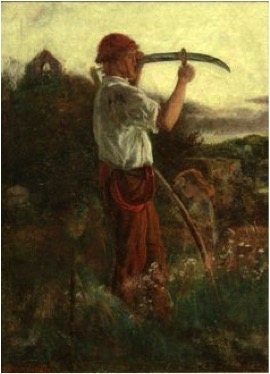Digital Post by Ally_EdwardSaid
I believe that creative storytelling, such as through movies, poems, digital stories and so on, has the potential to re-enchant our lives, and in doing so, helps us better manage our sadness and suffering. I will use Arthur Frank’s concept of the quest narrative to explore Daniel Tysdal’s lived experience with illness and loss.

Arthur Hughes, “The Scythe Sharpener” (1817).
In The Wounded Storyteller, Arthur Frank holds that quest narratives “meet suffering head on; they accept illness and seek to use it” (p. 115). Quest narratives require us to “continue to live in the story, becoming in it, reflecting on who one is becoming, and gradually modifying the story (p. 159). Arthur Frank provides us with valuable theoretical concepts but in many cases, he does not demonstrate how we can translate this knowledge into practice. For instance, in chapter 7, this author describes illness and suffering as a loss of “map” and direction and discusses that the ill-person must modify their story to be able to reach their ‘destination.’ However, Frank does not clarify how this can be achieved. Tysdal, on the other hand, provides us with all the tools needed to accomplish the goal of modifying our stories. One of such tools is the ability to either heighten or reduce the music in our stories, through the use of rhyme, alliteration and assonance, to achieve our desired musical effect. Perhaps we can use more music in our stories to create an optimistic narrative tone, leading to an optimistic outlook on our lives. Reducing the music in our stories would probably achieve the opposite effect, making our lived experience appear dull, monotone and pessimistic.
Moreover, Tysdal illustrates that using smiles and metaphors can enable us to connect our illness narratives to different events, individuals, experiences and so on, in order to give them form and substance. For instance, in order to make sense of the emptiness he felt following Blair’s suicide, Tysdal compares his friend’s ‘silent’ phone when he was unable to return his call to the coldness of winter and raging blizzards. To further emphasize and communicate his helplessness, desperation and inability of saving his friend’s life, the poet creatively uses the metaphor of invisible poker cards. In this example, not only does Blair’s death ‘feel’ like winter, but it is also like playing a game of poker with invisible cards.
Although Tysdal suffers greatly from the loss of his friend, his story can be viewed as a restitution narrative. This is because while the poet was unable to save Blair’s life literally, he is able to preserve it symbolically by writing about his friend in his poems. As such, Tysdal is able to arrive at his destination of acceptance through the art of poetry, enabling him to better cope with feelings of loss and pain.
*
In addition, Tysdal also shares his lived experience with depression in his article, TIFF is More to Me Than a Film Festival. The author shares personal details of the dullness that is depression and the feelings of exasperation which often accompany the illness. Tysdal also describes indulging in movies, particularly those played at the Toronto International Film Festival (TIFF) as a vital coping strategy. He is transformed into a more enchanted world through becoming absorbed in the events, experiences and lives of the movie character. To him, watching movies is a way of transgressing the boundaries of space, time and the human body.
According to Tysdal, the power of creative storytelling (through movies, poems, etc.) lies in its ability to connect us more deeply to the lives of the ‘makers’ and narrators. This relates to Arthur Frank’s notion of the communicative body. Becoming connected to one another through sharing and listening to each other’s stories creates a community of ‘communicative bodies’ (Frank, 1995, pp. 143-144).
Frank explains that in the quest narrative, the ill person is not simply a survivor, as this concept simply requires the individual to survive. However, he prefers to describe those who have suffered as ‘witnesses’ who have a moral responsibility to share and teach others about the experiences of pain and illness (Frank, 1995, p. 137). Similarly, by sharing his lived experience, Tysdal offers testimony regarding his depression. In doing so, he becomes connected to other sufferers through the communicative body.
Offering testimony regarding one’s suffering and through one’s story enables the ill-person to inspire others. Tysdal instills hope in his readers that depression can be manageable. He illustrates how using artistic tools, such as watching movies, may help re-enchant our lives and allow us the space to conflate fantasy and reality. After watching a film, the author might begin to view an everyday, mundane street as blooming “with entities that appear bigger than life and resonate with symbolic fervour—a wind-rippled willow, a streak of fluorescent graffiti, a gutter-bound pair of long johns.” Therefore, the art of creative storytelling may have numerous therapeutic effects.